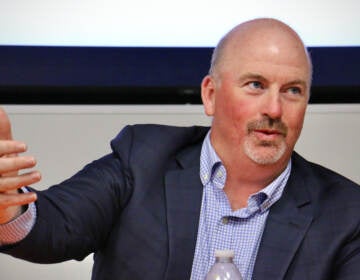Video fakery and the high cost of lies
Donald Trump's fans have had a tough time combating Pelosi, so apparently their only recourse was to manipulate video footage to smear her as semi-nuts.

Speaker of the House Nancy Pelosi, D-Calif., responds to reporters as she departs after meeting with all the House Democrats, many calling for impeachment proceedings against President Donald Trump after his latest defiance of Congress by blocking his former White House lawyer from testifying yesterday, at the Capitol in Washington, Wednesday, May 22, 2019. (AP Photo/J. Scott Applewhite)
In the first episode of the powerful HBO series “Chernobyl,” a pivotal Russian character is ruminating about the ’86 nuclear meltdown and the government’s subsequent disinformation campaign. He is speaking to his tape recorder: “What is the cost of lies? It’s not that we’ll mistake them for the truth. The real danger is that if we hear enough lies, then we no longer recognize the truth at all. What can we do then? What else is left, but to abandon even the hope of truth and content ourselves with ‘stories’?”
I thought of those lines the other day, when I saw the fake videos that depicted Nancy Pelosi as a drunken, barely coherent loon – videos that speedily traversed the sewers of social media. Of course they did, because in 2019 America there is a huge and willfully ignorant constituency that is more than happy to content itself with “stories” that trump fact with fiction. This is fertile turf for authoritarianism.
Donald Trump’s fans have had a tough time combating Pelosi – last Wednesday, the House Speaker said that Trump’s stonewalling of congressional subpoenas is tantamount to a “coverup,” a remark grounded in objective reality – so apparently their only recourse was to manipulate video footage to smear her as semi-nuts. A right-wing page on Facebook (natch) did the honors, and more than two million people watched her slur her words (the actor James Woods tweeted that she looked “drunk as a skunk”) even though, in truth, she wasn’t drunk and did not slur.
Meanwhile, “Lou Dobbs Tonight” on the Fox Business Network (you knew Fox would be involved somehow) spliced random segments from a Pelosi news conference to make it appear that she was a semi-coherent stutterer. And, sure enough, Trump personally amplified the lie on Thursday night by tweeting the Fox clip and declaring “PELOSI STAMMERS THROUGH NEWS CONFERENCE” – as did his lawyer, Rudy Giuliani, who tweeted, “What is wrong with Nancy Pelosi? Her speech pattern is bizarre.” (Giuliani later deleted his tweet.)
Granted, fakery in politics isn’t new; nor are conservatives the sole offenders (there’s a theory among some addled lefties that Melania Trump has a body double, based on a manipulation of certain photos). But the current technologically-driven threat to democracy is decisively asymmetric. None of the Democratic presidential candidates spend their time re-tweeting fake videos; Trump may not have created this dangerously toxic climate, but as the commander-in-chief in the war on facts, he is predictably its prime abetter.
And those Pelosi videos were actually low-tech smears; citizens had the ability (if not the desire) to compare the manipulated footage to the real thing. What’s most worrisome, with the 2020 election drawing near, is the potential for “deep fakes” – the nickname for sophisticated digital creations that are 100 percent fake, making it appear, for instance, that a candidate has said something that never happened at all.
In fact, Dan Coats, the current director of National Intelligence, told Congress in January that “adversaries and strategic competitors probably will attempt to use deep fakes or similar machine-learning technologies to create convincing – but false – image, audio, and video files to augment influence campaigns directed against the United States.” And a Defense Department official recently told ABC News that this technology is so readily available that these manipulations “can now potentially be done at home” by lone wolves.
Republicans were predictably silent when Trump amplified the Pelosi fakery, and they said virtually nothing about the fakery itself. But over the weekend, there was one exception. Texas congressman Will Hurd, who occasionally slips the leash of lockstep servility, told CBS News that video disinformation strikes “at the heart of our democracy.” He said that “within months, we’re going to be able to see this deep fake technology continue to grow. We’re not prepared…You have leaders that don’t understand how this technology can be used in the future…We can’t be promoting this stuff, and if you can’t tell the difference between a doctored piece of information and not, that’s troubling as well.”
The danger, in 2020, is that untold millions won’t even care to delineate the difference between fiction and fact. If Trump fans digitally concoct videos that purport to show how his tariffs are making American farmers rich, or that purport to show how the threat of climate change is magically receding, or purport to show that the eventual Democratic nominee voiced support for Karl Marx and the execution of newborns, a sizeable share of partisan voters will be perfectly happy to share those stories. And Facebook won’t try to vet them, or delete them; as Monica Bickert, its “product policy” executive, told CNN the other day, “We aren’t in the news business. We’re in the social media business.”
So gird yourself for 2020, when we may well be compelled to ponder the high cost of lies. What, indeed, can we do then?
WHYY is your source for fact-based, in-depth journalism and information. As a nonprofit organization, we rely on financial support from readers like you. Please give today.




